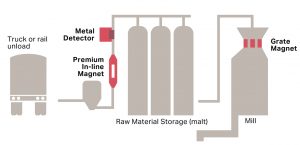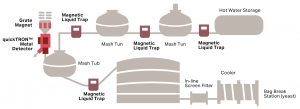Get in touch with us at our toll-free number 1-800-835-2526 or request a quote here:
Getting Metal Out of Beer with Metal Detection and Magnetic Separation

During the beer brewing process, tramp metal such as screws, nails, and metal shavings can be introduced into the product flow. If not removed, metal contamination can cause serious damage to processing equipment and even affect how the beer tastes. It’s unlikely that any of us would ever find an actual piece of metal while enjoying an ice-cold pint of beer, but metal contamination can certainly cause damages at processing plants that could result in supply chain shortages due to repair-induced downtime. In this article, we will examine the best metal detection and magnetic separation methods to combat tramp metal in the beer brewing process.

With beer brewing, just as with any other food or beverage process, there are many locations where harmful metal contamination can be introduced. Because raw materials are first collected from fields, then transported to the brewery on trucks, it is impossible to avoid contamination from metal and other materials.
Here, we will examine a typical brewery and identify where metal detectors and magnetic separators can be placed to combat metal contamination.
Raw Materials

Location 1—Malt In-Feed Line
After malt has been delivered, typically by rail or truck, it is then commonly pneumatically transported into storage silos. Here, a pneumatic inline magnet can be used independently or in combination with metal detection. Working independently, the pneumatic inline magnet will capture ferrous tramp metal and effectively remove it from the process flow. A metal detector will be able to identify and automatically remove non-ferrous metals as well. It is recommended that magnetic separators and metal detectors are used together in order to achieve maximum metal contaminant removal.
Pneumatic inline magnets are designed to easily fit into existing pipelines without causing any obstruction or disruption to the process. Within the housing, a strong plate magnet (featuring either deep-field ferrite magnets or intensely powerful rare earth magnets) is mounted on one side to attract and firmly hold ferrous metal so that it does not re-enter the process. Captured metal contamination is then manually removed based on a schedule determined by the needs of the processing facility.
Metal detection equipment is able to identify, then automatically eject any metal contamination that remains, whether it is ferrous or non-ferrous. At this stage in the process, metal contamination present is typically ferrous. Because of this, it is best to install the metal detector at a point in the processing line after the pneumatic inline magnet. This will reduce the amount of metal detection rejects that occur, and thus reduce loss of good product. There are several different metal detectors designed for use in pneumatic lines, and the final selection will be made according to the needs of the specific installation.
• Technical Product Information: Pneumatic Inline Magnets
• Technical Product Information: Pneumatic Metal Detectors
Location 2—Prior to Milling
Positioning grate (or grid) magnets in or above the in-feed hopper to the mill is a simple way to protect against potentially catastrophic and costly metal damage to the mill. To achieve maximum protection, it is recommended to install grate magnets featuring neodymium iron boron rare earth tube magnets, the strongest permanent magnets available at this time.
The design of a grate magnet is simple. A series of tube magnets are organized in a grid, which then easily fits within a hopper. Then, deflection bars mounted above the tube magnets are able to deflect product onto the surface of the magnets. This ensures the maximum capture of magnetic particles.

Location 3—Hot Water Feed to Mash Tun
One of the most common—and most overlooked—sources of metal contamination in food processing plants is water. Because of the nature of water, it means that rust is a common problem. To combat this issue, magnetic liquid traps can be implemented to attract and capture any rogue ferrous metal—including metal in a very fine form, such as rust. It is easy to fit a magnetic liquid trap into a pipeline with flanges or any other standard connector. Within the body of the magnetic liquid trap, high strength rare earth neodymium tube magnets project their magnetic field down into the material flow, attracting and capturing any ferrous or weakly magnetic materials. The tube magnets within the magnetic liquid trap are then removed and manually cleaned on a scheduled frequency.
• Technical Product Information: Magnetic Liquid Traps
Location 4—Between Mash Tuns, Mash Tubs, and Whirlpool/Settling Tank
It is common to place magnetic liquid traps between the mash tuns, mash tub, and whirlpool/settling tank, particularly if there has only been limited production present at earlier stages in the beer making process.
Location 5—Hops In-Feed Line
It is important to introduce another layer of protection at any stage in the process where new materials are being introduced to the processing line. Grate magnets in combination with a quickTRON metal detector ensure that the hops entering the mash tub are metal-free. The quickTRON is designed for handling free-fall material, and as material flows into it, any metal present is detected, then automatically rejected. The grate magnet, equipped with powerful rare earth neodymium magnets, is positioned prior to the metal detector in order to catch ferrous metal and reduce the amount of feed material lost during the metal detector rejection process.
• Technical Product Information: quickTRON Metal Detector
Location 6—Between Mash Tub and Whirlpool/Settling Tank
Following the mash tub, a magnetic liquid trap will provide final protection prior to settling. In this instance, it is vital to use a Bunting magnetic liquid trap equipped with special neodymium magnets that are specifically designed to withstand high temperatures. This is because standard neodymium rare earth magnets are at risk of permanent loss of magnetic power in high temperature environments.
Fermentation and Finishing

Location 7—Yeast In-Feed Line
Similarly to the hops in-feed line, here, a combination of a grate magnet with a quickTRON metal detector ensures that any metal present does not enter the process as externally-supplied yeast is being added.
Location 8—Between Beer Conditioning Tank and Filter
In order to protect the filter, it is recommended that a magnetic liquid trap is installed after the conditioning tank.
Location 9—Prior to Beer Bottling
Just like in other food processing plants, it is best practice to install a final metal detector at the last stage of the process. This provides a last stage of protection and ensures that any metal introduced into the beer making process from damaged processing equipment, such as in the filter or in the pipes, is successfully detected and removed.
In this blog, we have examined a typical example of a beer brewing operation. However, each plant is unique, and we always recommend reaching out to Bunting in order to determine the best metal removal solutions to implement within your unique facility.